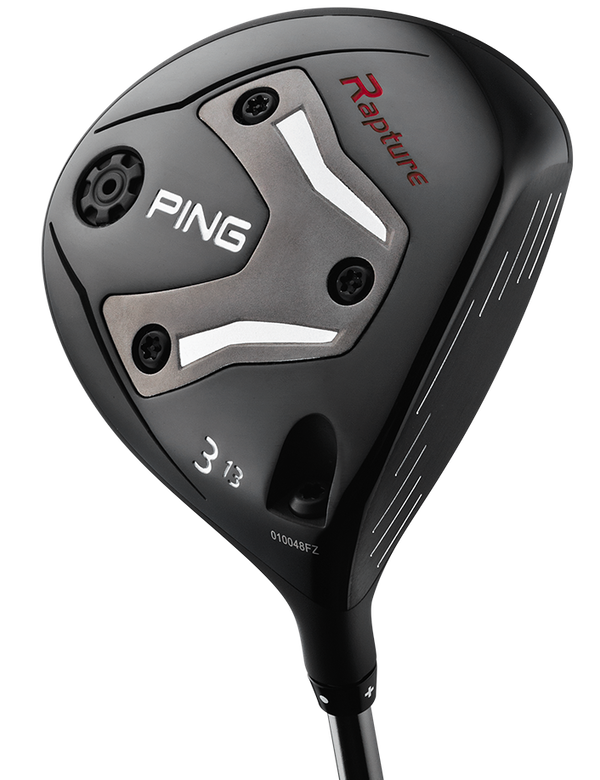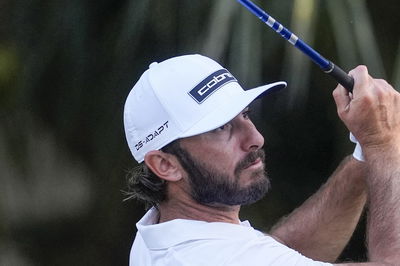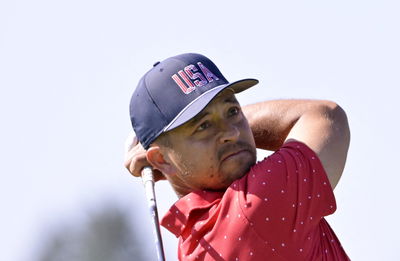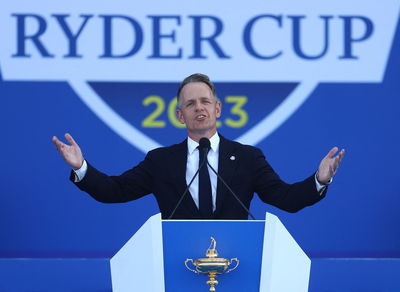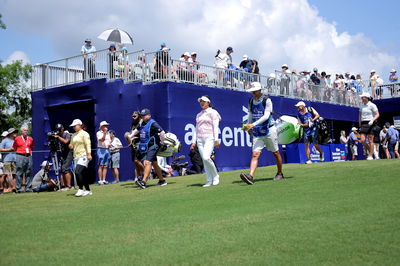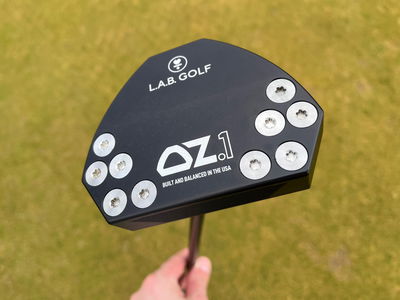PGA Show: Interview with Mizuno club engineer Chris Voshall
'I feel like this year's offerings from TaylorMade are pretty weak'
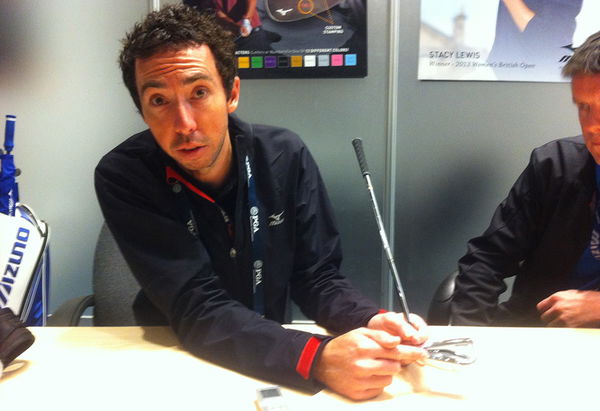
Chris, as we all know by now, 'nothing feels like a Mizuno'. How important is Mizuno's Grain Flow Forging process in ensuring this?
Hi there Golfmagic. The Grain Flow Forging process is a Mizuno patent, it's something that we hold a joint patent with Chuo-Ku, our forging foundry. It's in Hiroshima, Japan, and we co-developed with them so we're the only ones who can use this process. How it differs from a traditional, old-school forging - both are billet forged (start with a billet of steel and pound it into shape) - is that our process involves a stretching and bending process. That's really what our patent is. You take the billet, which is long tube, stretch and bend it to the approximate lie angle and from there, we know through the preparation of that billet, the grain structure of that billet is going from toe to heel. So when you stretch it and bend it into that shape, then when it's forged, you get longer and more continuous grains and it continues and flows throughout the head. With the traditional forging, when you through into a forging, it's like the mold is right here, and you literally just place a billet in and the hammer hits it. It's very unprecise in terms of exactly where everything is going to flow because that metal sometimes there will be more flash (extra stuff that hangs off) material down here, less up here. With the Grain Flow Forging, by bending it and stretching it beforehand, we get very consistent flash and that is proof it's always flowing the same way and that we have those longer, more continuous grains. That is really where you get that feel of the head actually vibrating a bit longer because those longer grains are going to help keep that true vibration.
What was the reason for departing from Mizuno's tradtional chrome and satin finish with the JPX-EZ line for 2014?
A lot of that was to do with trying to reach out to a different customer. We've always been known for that chrome, blue, silver, really understated design, but we really wanted to try push the envelope a lot with this design in terms of head spec, shape, look at address, everything really. Rather than get lost in the shuffle on the shelf of just a slighter larger head than our older ones, we wanted to completely remove it and get it as far away as we could from anything else, so we went for a darker finish. Aside from that as a little bonus, the darker finish also makes it hide the size of the face at bit.
What's been the feedback both on Tour and with consumers of the JPX-EZ?
It's been phenomenal. Charles Howell III has actually got some JPX-EZ Forged long irons in play. The feedback has been great. It's done what we wanted it to do in terms of reaching out to a different customer. It's very un-Mizuno like and that was the goal, to bring some other higher handicap guys to our brand. Guys who aren't used to seeing us. We wanted to throw them something different that they might look. Sales have been phenomenal.
Moving on to quite possibly the sexiest looking iron I've ever seen, what's been the Tour validation and feedback of the new better player Mizuno MP-4?
That's been great. With the MP-4, it was our chance to set the muscle. We almost stripped it of technology, stripped it of any flash. We wanted it to be so pure, so clean. It's even a smaller head than our previous blades, smaller from toe to heel, smaller topline, smaller sole, and the feedback has just been amazing. We have many in play by non-contracted players on both PGA and European Tour. We may even have more non-Mizuno guys playing it than Mizuno guys, which speaks volumes. The other guys are seeking us out to play this blade and it just speaks to that true, pure player.
And the MP-54?
Also great. On the PGA Tour, MP-54 is a little bit in no man's land. We actually have a few non-contracted players have it in the long irons, splitting sets with the MP-64. In terms of overall sales, it hits a sweetspot of the Mizuno player where it still has that MP look at address, small, compact, thin topline, but has that hidden MP technology to help launch the ball. It has the feel and workability of an MP club, knock it down, do whatever you want with it. Sales our great and we expect it to be our best selling MP iron ever.
Not only do Mizuno irons feel and look great, they sound great. Could we learn a little more about Mizuno's Harmonic Impact Technology?
Yeah, this is something really we started pressing further as, you know when you're designing like a classic muscleback for over the past ten years in forgings, it was very predictable as to how the head was going to vibrate and you knew what it was going to do. But now with the use of new technology, we're trying to push extremes in the club head for better performance, for higher COR, deeper centre of gravity. The Harmonic Impact Technology is really our term for how we analyse a head in the 3D world before it becomes real. Through our CAD
Chris, as we all know by now, 'nothing feels like a Mizuno'. How important is Mizuno's Grain Flow Forging process in ensuring this?
Hi there Golfmagic. Well first things first, the Grain Flow Forging process is a Mizuno patent, held jointly between Mizuno and the Chuo forging house in Hiroshima, Japan. We co-developed with them so we're the only ones who can use this process. How it differs from a traditional, old-school forging - both are billet forged (start with a billet of steel and pound it into shape) - is that our process involves stretching and bending. That's really what our patent is. You take the billet, which is a long tube, stretch and bend it to the approximate lie angle and from there, we know through the preparation of that billet, the grain structure of that billet is going from toe to heel. So when you stretch it and bend it into that shape, then when it's forged, you get longer and more continuous grains and it continues and flows throughout the head. With the traditional forging, when you throw into a forging, it's like the mold is right here, and you literally just place a billet in and the hammer hits it. It's very unprecise in terms of exactly where everything is going to flow because sometimes there will be more flash (extra stuff that hangs off) material down here, less up here. With the Grain Flow Forging, by bending it and stretching it beforehand, we get very consistent flash and that is proof it's always flowing the same way and that we have those longer, more continuous grains. That is really where you get that feel of the head actually vibrating a bit longer because those longer grains are going to help keep that true vibration.
What was the reason for departing from Mizuno's traditional chrome and satin finish with the JPX-EZ irons for 2014?
A lot of that was to do with trying to reach out to a different customer. We've always been known for that chrome, blue, silver, really understated design, but we really wanted to try push the envelope a lot with this design in terms of head spec, shape, look at address, everything really. Rather than get lost in the shuffle on the shelf of just a slighter larger head than our older ones, we wanted to completely remove it and get it as far away as we could from anything else, so we went for a darker finish. Aside from that as a little bonus, the darker finish also makes it hide the size of the face at bit.
What's been the feedback both on Tour and with consumers of the JPX-EZ and JPX-EZ Forged irons?
It's been phenomenal. Charles Howell III has actually got some JPX-EZ Forged long irons in play. The feedback has been great. It's done what we wanted it to do in terms of reaching out to a different customer. It's very un-Mizuno like and that was the goal, to bring some other higher handicap guys to our brand. Guys who aren't used to seeing us. We wanted to throw them something different that they might look at. Sales have been phenomenal.
Moving on to quite possibly the sexiest looking iron we've ever seen, what's been the Tour validation and feedback of the new better player Mizuno MP-4?
That's been great. With the MP-4 (pictured above) it was our chance to set the muscle. We almost stripped it of technology, stripped it of any flash. We wanted it to be so pure, so clean. It's even a smaller head than our previous blades, smaller from toe to heel, smaller topline, smaller sole, and the feedback has just been amazing. We have many in play by non-contracted players on both PGA and European Tour. We may even have more non-Mizuno guys playing it than Mizuno guys, which speaks volumes. The other guys are seeking us out to play this blade and it just speaks to that true, pure player.
And the MP-54?
Also great. On the PGA Tour, MP-54 is a little bit in no man's land. We actually have a few non-contracted players using them in the long irons, splitting sets with the MP-64. In terms of overall sales, it hits a sweetspot of the Mizuno player where it still has that MP look at address, small, compact, thin topline, but has that hidden MP technology to help launch the ball. It has the feel and workability of an MP club, knock it down, do whatever you want with it. Sales are great again, and we expect it to be our best selling MP iron ever!
Not only do Mizuno irons feel and look great, they sound incredible at impact too. Could we learn a little more about Mizuno's Harmonic Impact Technology?
Yeah, this is something really we started pressing further as, you know when you're designing like a classic muscleback for over the past ten years in forgings, it was very predictable as to how the head was going to vibrate and you knew what it was going to do. But now with the use of new technology, we're trying to push extremes in the club head for better performance, for higher COR, deeper centre of gravity. This leads to things in the design that are untraditional. So the Harmonic Impact Technology is really our term for how we analyse ahead in the 3D world before it becomes real. Through our CAD simulation, we can actually vibrate a head and simulate an impact and we'll know which areas need specifically enforcing and which areas we can steal meat from. We can thin this area out because it's not going to affect the feel. So the ultimate goal is to make everything feel like an MP-4, like a true blade. We know the characteristics of the first mode through tenth mode of vibration of an MP-4 and then we try to do our best to get every product to line up as close as we can to that. We've also added weight to the MP-4 irons by increasing the size of the muscle pad behind the sweetspot, which is the reason for the irons’ pronounced bulge in the back. The added mass amplifies the MP-4’s Harmonic Number. By raising the harmonic number, and tweaking the shape of the muscle pad to ensure that the frequencies have even levels, engineers can create a more pleasing sound that translates into the sticky, soft feel at impact that golfers rave about.
